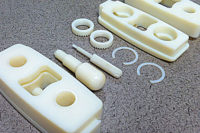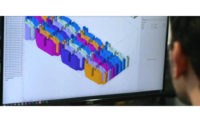Beer drinkers have debated for years about whether the taste of a bottle of beer improves with age. What they agree upon, however, is that the longer a company makes beer, the better the odds that it produces a great-tasting product, glass after glass.
With corporate headquarters based in Amsterdam, Heineken has been brewing beer since 1873, and continually growing in popularity. The company currently operates more than 150 breweries around the world that brew its classic green-bottled lager, along with other brands.
One is Cruzcampo, which is the biggest-selling beer in Spain. Heineken has owned the brand since 1991, and in 2008, the company opened a new brewery in Seville that can produce 132 million gallons of beer annually.
A decade later, the facility’s packaging manager, Juan Padilla Gonzalez, was assigned the task of finding a way to more quickly and cost-effectively produce new parts for plant equipment. His research ultimately led him to consider trying 3D printing.
Gonzalez purchased several 3D printers from Ultimaker B.V., located in Geldermalsen, Netherlands, and put them to the test with fellow team members. Because worker safety is a major concern at the Seville plant, Gonzalez and his team began its 3D printing project by making safety latches for use during machine maintenance.
The latches are printed from bright red filament and fit onto nearly all the machines at the brewery. Their color makes the parts conspicuous so workers know the benefits of 3D printing. But, more importantly, the latches prevent the machines from being turned on until maintenance is complete.
Gonzalez and his team then explored 3D printing spare plastic parts to replace damaged or broken metal components. They learned that the parts could be rapidly produced in-house, significantly reducing machine downtime.
Verifying 3D printing’s ability to optimize part designs occurred just as fast. Team engineers quickly created, tested and tweaked part designs until the desired properties and functionality were obtained. In one case, the team redesigned a conveyor-belt metal sensor element that was installed to verify bottle quality, but, instead, frequently caused the bottles to jam. The 3D-printed plastic part eliminates the possibility of jamming.
Finally, the team looked into 3D printing tools for machine maintenance. Most of the tools were printed from Tough PLA (polylactic acid), which offers high strength and is as durable as ABS.
One is a stopper tool that loosens and tightens the columns of guiding wheels that apply bottle labels. Isabelle Haenen, a member of the global supply chain procurement department at Heineken, says 3D printing the tool resulted in a 70 percent cost savings and a delivery time reduction from three days to one when compared to CNC machining. Simpler tools, like a circular rubber cutter, are printed in less than one hour.
Initially, Gonzalez’s team worked with Ultimaker 2+ printers, before switching to S5 machines. The 2+ features interchangeable nozzles, a heated glass build plate and an open filament system.
Model S5 is the company’s latest machine, and it features active bed leveling to ensure a perfect first layer. Also standard are controlled airflow, and a filament flow sensor that automatically pauses printing to notify the operator when no more material is available.
For more information on 3D printers, call 888-229-9046 or visit https://ultimaker.com.





